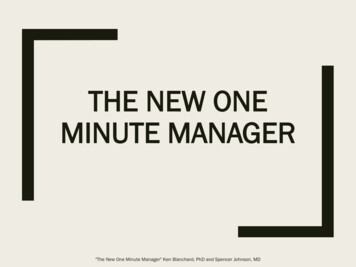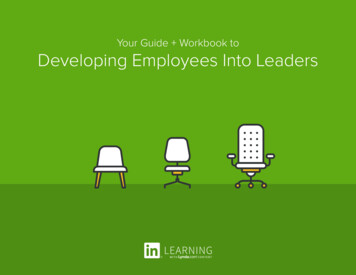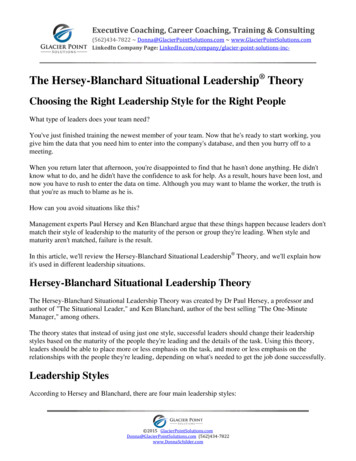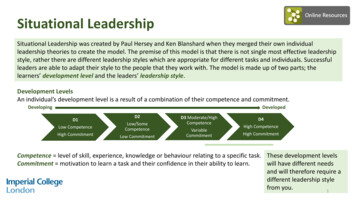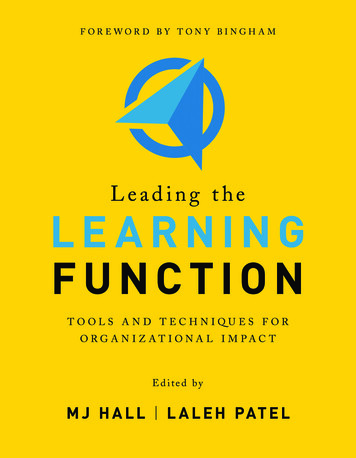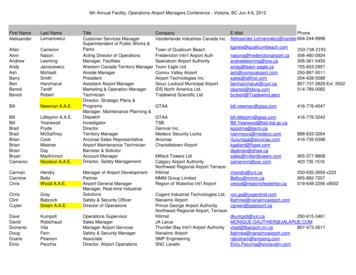
Transcription
SAMPLESELF LEADERSHIP
Personal Learning PurposeExamples Improve communications—and myrelationship—with my manager Understand my own needs better so I canask for what I need Gain the mindset and skillset of a selfleader so I can achieve my goalsback from taking advantage of growthopportunities Replace victim mentality with a sense ofautonomy Take the time to reflect and learn from theinside outSAMPLE Learn a new language of leadership to help Break through barriers that hold meget what I need when I need it Take my career to the next levelMy personal learning purpose is to .An Assumed Constraintis a belief that limitsnew experiences.Challenge yourAssumed Constraintsor they will limityour success. 2017 The Ken Blanchard Companies. All Rights Reserved. Reproduce Only with Written Permission. V031517 EL22114
Self ctiveSAMPLEActivatePoints ofPowerSkillset1Goal Setting2Diagnosing3Assessing your competence andcommitment on a specific goal or taskAlignmentAligning on what needs to be done, whenMatchingGetting the leadership style that providesyou with what you need 2017 The Ken Blanchard Companies. All Rights Reserved. Reproduce Only with Written Permission. V031517 EL22118
Are Your Goals SMART?IndividuallyWith a Partner1. Transfer your goals from the GoalsWorksheet into the first column.3. Draw a check mark inthe associated columnif you think the goalmeets that SMARTcriterion.2. Remember to write each goal as anoutcome that needs to be achieved andby when.5. Determine and markwith an X if your goalneeds to be Clarified,Negotiated, orReframed.SAMPLE4. Draw an X if you thinkthe goal does not meetthat SMART criterion.Goals—Outcome that needs to beachieved and by whenSMARTDoes my goalneed to be .? Clarified Negotiated Reframed Clarified Negotiated Reframed Clarified Negotiated Reframed Clarified Negotiated Reframed Clarified Negotiated Reframed 2017 The Ken Blanchard Companies. All Rights Reserved. Reproduce Only with Written Permission. V031517 EL221116
Diagnosing CompetenceCompetence is notpotentialCompetence is your1. Demonstrated goal- or task-specific knowledgeand skills2. Demonstrated transferable knowledge and skillsSAMPLEDemonstrated goal- or task-specific knowledge and skillsGoal- or task-specific knowledge and skills represent expertise that comes from learning andexperience. When you have demonstrated goal- or task-specific knowledge and skills, you Understand what the goal requires (what) Can describe what a good job looks like (what) Have successfully done the goal or task before (what) Can show examples of work (what) Can describe how to achieve the goal (how) Know how long it takes to achieve the goal (how) Could teach someone how to do this goal or task (how)Demonstrated transferable knowledge and skillsTransferable knowledge and skills are generic skills that can be used in many situations, ondifferent goals. Examples of transferable knowledge and skills are Company knowledge Networking skills Technology skills Planning skills Time-management skills Culture knowledge Interpersonal skills Influencing skills Project-management skills Problem-solving skills 2017 The Ken Blanchard Companies. All Rights Reserved. Reproduce Only with Written Permission. V031517 EL221124
Diagnosing CommitmentCommitment is your1. Motivation to perform the goal or task2. Confidence to perform the goal or taskSAMPLEMotivationMotivation is the quality of your interest in and enthusiasm for the goal or task. If you aremotivated, you are Energized about the goal Focused on the goal Positive about the goal Passionate about the goalConfidenceConfidence is your feeling of being able to achieve a goal or perform a task well without a lot ofdirection or support from your leader. If you are confident on a goal or task, you are Self-assured Independent Self-reliant Willing to initiateDevelopment LevelsD4D3HighCompetenceModerate to Low to ighCommitmentDEVELOPINGDevelopment Levels 2017 The Ken Blanchard Companies. All Rights Reserved. Reproduce Only with Written Permission. V031517 EL221125
Which Leadership Style Are You Receiving?S3SupportingS2CoachingLet’s Talk; Leader DecidesThe Leader .The Leader .SAMPLELet’s Talk; D3 Decides1. Asks D3 for input about whatand how1. Explores concerns andencourages2. Listens and encourages2. Explains why3. Facilitates problem solving byasking open-ended questions3. Redirects and reteachesS4Delegating4. Involves in problem solvingS1DirectingD4 DecidesLeader DecidesThe Leader .The Leader .1. Acknowledges expertise1. Acknowledges transferable skillsand/or commitment2. Supports autonomy3. Invites innovation and ongoinglearning2. Gives direction about what,how, and when3. Checks in frequentlyA leader is anyone who can give youthe direction or support you need 2017 The Ken Blanchard Companies. All Rights Reserved. Reproduce Only with Written Permission. V031517 EL221138
Five Points of PowerPosition PowerSAMPLEHaving the title or authority tomake certain decisionsKnowledge PowerHaving relevant experience,expertise, or credentialsTask PowerHaving control over a task orparticular jobRelationship PowerBeing connected or friendly withother people who have powerPersonal PowerHaving interpersonal and leadershipskills, passion, inspiration, or apersonal vision of the future 2017 The Ken Blanchard Companies. All Rights Reserved. Reproduce Only with Written Permission. V031517 EL221141
Activate My Points of PowerSAMPLE1. How do I feel about my Points of Power chart? What strikes me about it? What do I notice?2. Do I have any assumed constraints that become apparent as I consider my Points of Powerchart?3. What are the implications of my Points of Power chart? How can I activate my Points of Power?Not realizing yourown power could beyour greatest assumedconstraint.Activate your Pointsof Power to do moregood—for yourself andfor others. 2017 The Ken Blanchard Companies. All Rights Reserved. Reproduce Only with Written Permission. V031517 EL221143
SAMPLEMaria’s D3 Conversation1. What did you notice about Maria in the video? What did she do?2. How did George respond? What did he do?Go beyond problem spottingto problem solving 2017 The Ken Blanchard Companies. All Rights Reserved. Reproduce Only with Written Permission. V031517 EL221155
D3 Conversations—What If?This Self Leader is meeting to get support from a coworker.CoworkerI need your support. I’ve been assigned a goalto improve our accounts receivable collectionsby ten percent over the next six months. It’staken me six weeks to figure out how the systemworks, evaluate problems, and come to an ideaof how to fix it. Even though I think my idea willwork, I’m hesitant to propose it. You’ve workedwith the CFO for years. Am I worried aboutnothing?You want my advice? Just do it. If it works, youwin. If it doesn’t work? Well, you know the oldsaying, “It’s easier to ask for forgiveness than toask for permission.”SAMPLESelf LeaderSelf Leader’s OptionsAs the Self Leader, what might you do to build your own confidence and motivation to sellyour solution to your manager? (Hint: engage in proactive problem solving) 2017 The Ken Blanchard Companies. All Rights Reserved. Reproduce Only with Written Permission. V031517 EL221156
Next StepsYour MASTER AssignmentsSAMPLE1. Use the Perceptions of Self Leadership Interpretation Guide toincorporate your manager’s responses and interpret the results.2. Use the One on One Worksheet to plan for a One on One Conversationwith your manager.3. Schedule and conduct a One on One Conversation with your managerwithin the next two weeks. 2017 The Ken Blanchard Companies. All Rights Reserved. Reproduce Only with Written Permission. V031517 EL221166
Task Power Having control over a task or particular job Personal Power Having interpersonal and leadership skills, passion, inspiration, or a personal vision of the future Knowledge Power Having relevant experience, expertise, or credentials Relationship Power Being connected or friendly with other people who have

